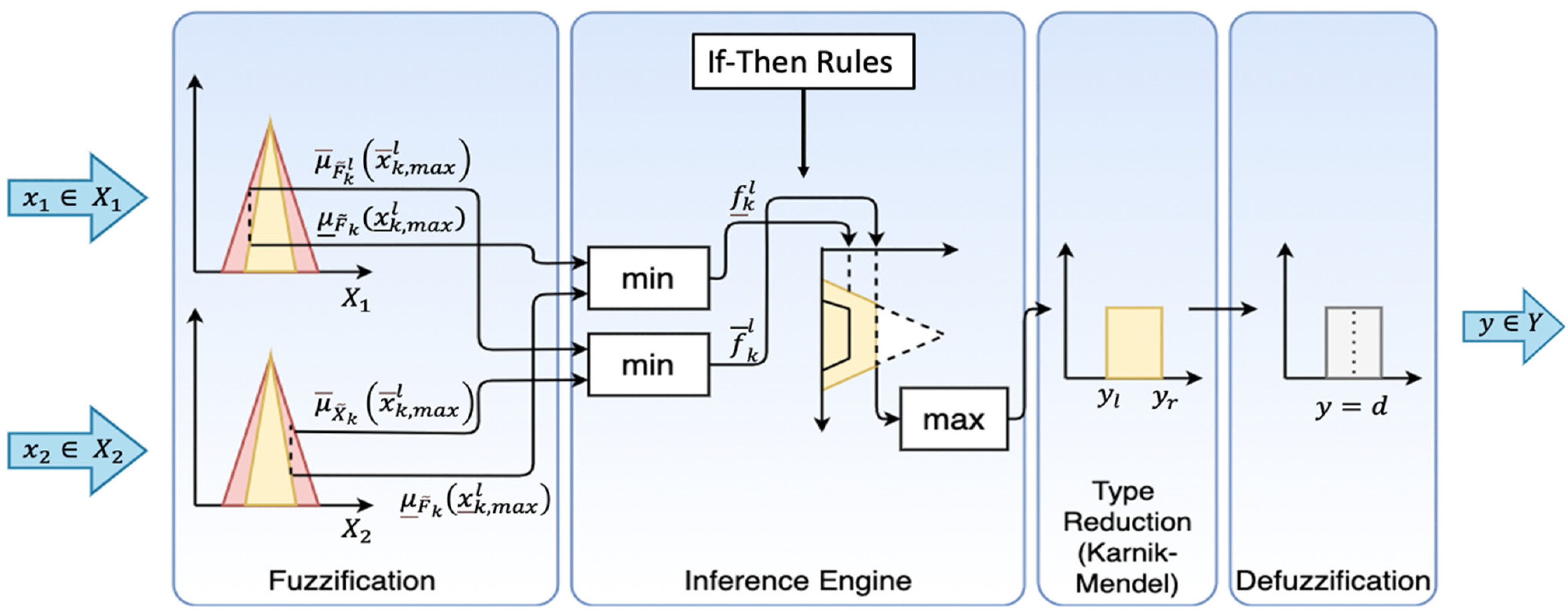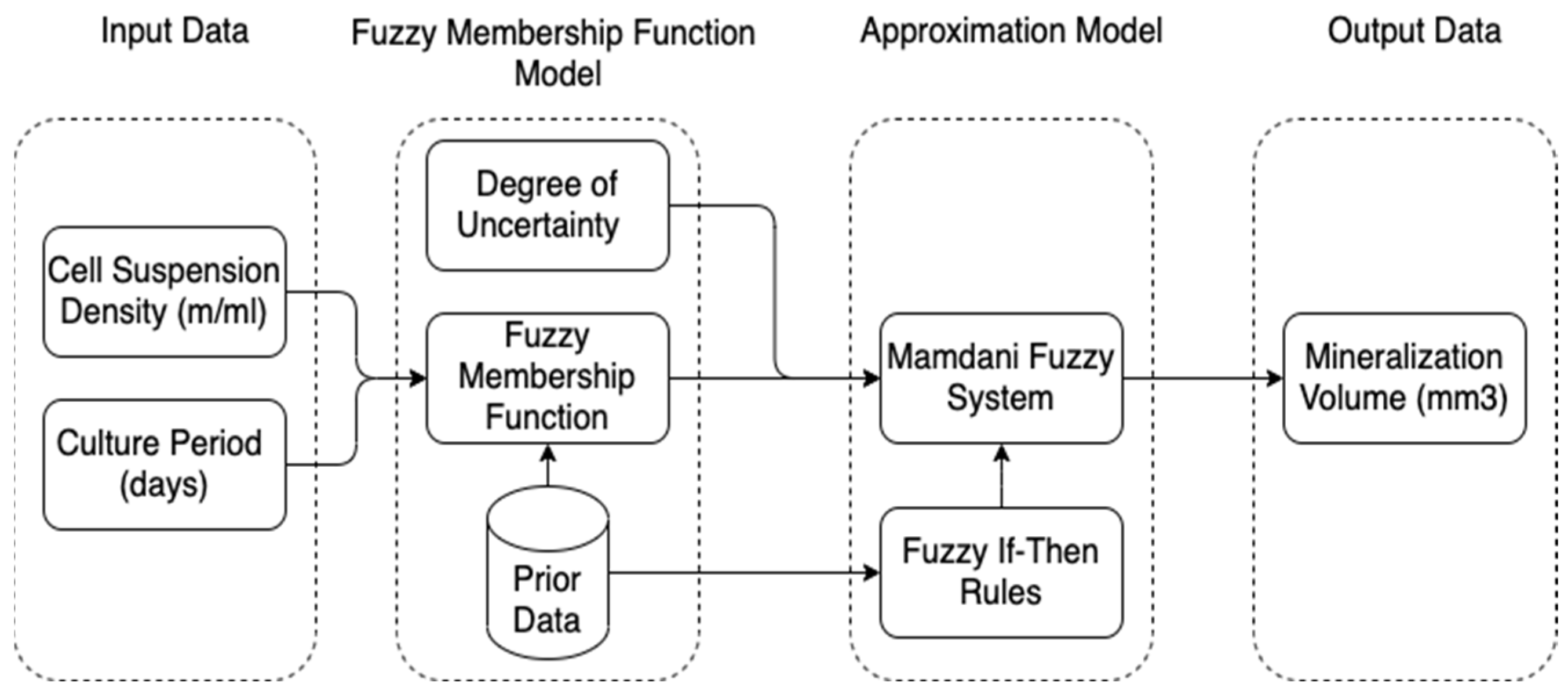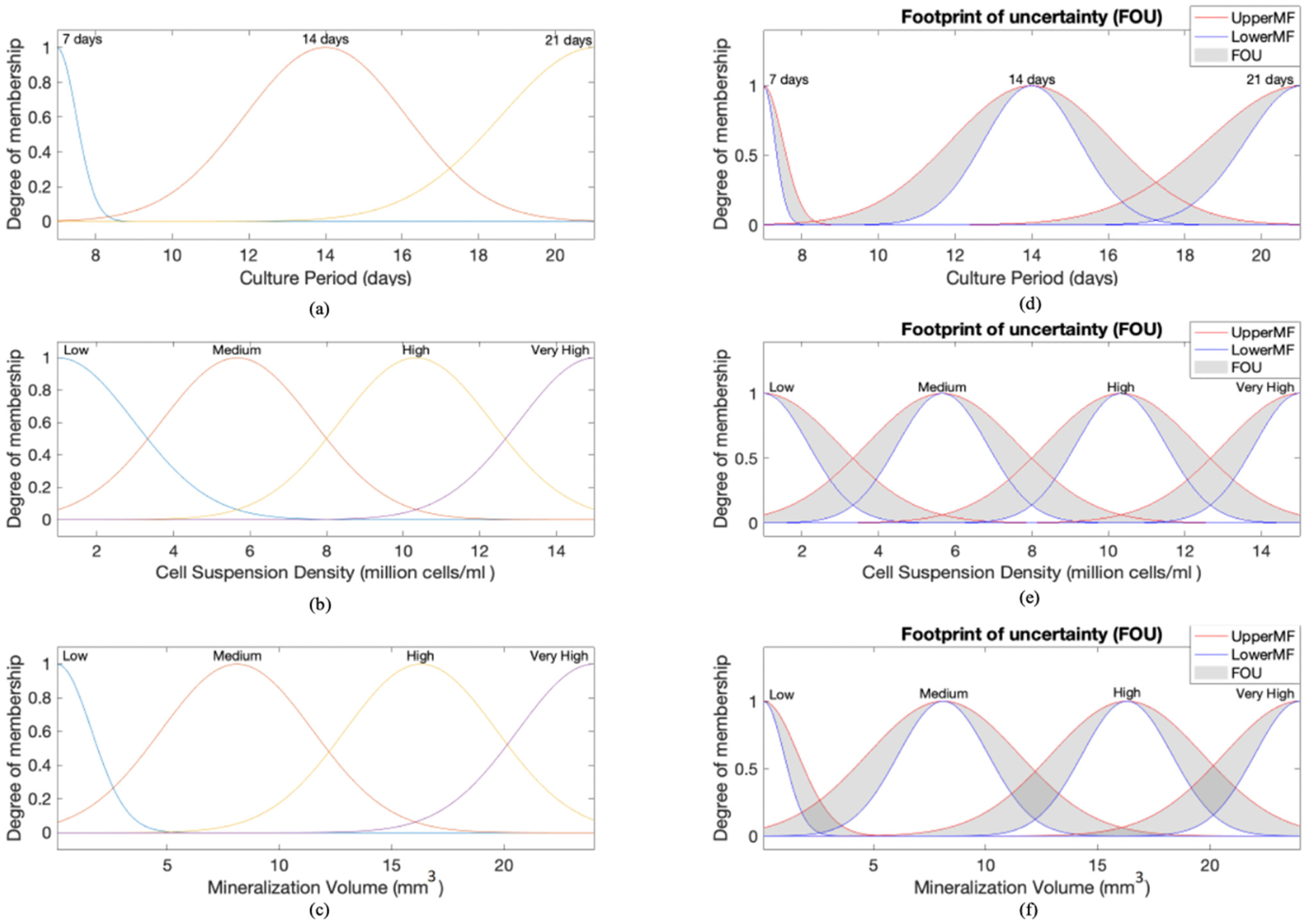Optimizing Mineralization of Bioprinted Bone Utilizing Type-2 Fuzzy Systems
Abstract
1. Introduction
Type-2 Fuzzy System
2. Methods
2.1. Fuzzy Inference Engine
2.2. Membership Function Variables and Parameterization
2.3. If-Then Rules Establishment
2.4. Fuzzy Inference Process
- Fuzzification of the input variables;
- Application of the fuzzy operator (AND) in the antecedent;
- Implication from the antecedent to the consequent;
- Aggregation of the consequent across the rules;
- Defuzzification.
- Fuzzification of the input variables;
- Application of the fuzzy operator (AND) in the antecedent;
- Convert T1 MF to T2 MF with 0.2 and 0.3 lag;
- Implication from the antecedent to the consequent;
- Aggregation of the consequent across the rules;
- T2 FS to T1 FS type reduction by Karnik–Mendel;
- Defuzzification.
3. Results
4. Discussion
Author Contributions
Funding
Data Availability Statement
Acknowledgments
Conflicts of Interest
References
- Sedigh, A.; Kachooei, A.R.; Beredjiklian, P.K.; Vaccaro, A.R.; Rivlin, M. Safety and Efficacy of Casting During COVID-19 Pandemic: A Comparison of the Mechanical Properties of Polymers Used for 3D Printing to Conventional Materials Used for the Generation of Orthopaedic Orthoses. Arch. Bone Jt. Surg. 2020, 8, 281–285. [Google Scholar] [CrossRef] [PubMed]
- Sedigh, A.; Ebrahimzadeh, M.H.; Zohoori, M.; Kachooei, A. Cubitus Varus Corrective Osteotomy and Graft Fashioning Using Computer Simulated Bone Reconstruction and Custom-Made Cutting Guides. Arch. Bone Jt. Surg. 2020, 9, 467–471. [Google Scholar] [CrossRef]
- Derakhshanfar, S.; Mbeleck, R.; Xu, K.; Zhang, X.; Zhong, W.; Xing, M. 3D bioprinting for biomedical devices and tissue engineering: A review of recent trends and advances. Bioact. Mater. 2018, 3, 144–156. [Google Scholar] [CrossRef]
- Murphy, S.V.; Atala, A. 3D bioprinting of tissues and organs. Nat. Biotechnol. 2014, 32, 773–785. [Google Scholar] [CrossRef] [PubMed]
- Koo, T.K.; Li, M.Y. A Guideline of Selecting and Reporting Intraclass Correlation Coefficients for Reliability Research. J. Chiropr. Med. 2016, 15, 155–163. [Google Scholar] [CrossRef]
- Webb, B.; Doyle, B. Parameter optimization for 3D bioprinting of hydrogels. Bioprinting 2017, 8, 8–12. [Google Scholar] [CrossRef]
- Sedigh, A.; Tulipan, J.E.; Rivlin, M.R.; Tomlinson, R.E. Utilizing Q-Learning to Generate 3D Vascular Networks for Bioprinting Bone. bioRxiv 2020. [Google Scholar] [CrossRef]
- Suntornnond, R.; Tan, E.Y.S.; An, J.; Chua, C.K. A Mathematical Model on the Resolution of Extrusion Bioprinting for the Development of New Bioinks. Materials 2016, 9, 756. [Google Scholar] [CrossRef]
- Sedigh, A.; DiPiero, D.; Shine, K.M.; Tomlinson, R.E. Enhancing precision in bioprinting utilizing fuzzy systems. Bioprinting 2022, 25, e00190. [Google Scholar] [CrossRef]
- Sedigh, A.; Ghelich, P.; Quint, J.; Samandari, M.; Tamayol, A.; Tomlinson, R.E. Approximating Scaffold Printabil-ity Utilizing Computational Methods. bioRxiv 2022. [Google Scholar] [CrossRef]
- Torres, A.; Nieto, J.J. Fuzzy Logic in Medicine and Bioinformatics. J. Biomed. Biotechnol. 2006, 2006, 091908. [Google Scholar] [CrossRef] [PubMed]
- Olofsson, S.; Mehrian, M.; Calandra, R.; Geris, L.; Deisenroth, M.P.; Misener, R. Bayesian Multiobjective Optimisation With Mixed Analytical and Black-Box Functions: Application to Tissue Engineering. IEEE Trans. Biomed. Eng. 2018, 66, 727–739. [Google Scholar] [CrossRef] [PubMed]
- Göhl, J.; Markstedt, K.; Mark, A.; Håkansson, K.M.O.; Gatenholm, P.; Edelvik, F. Simulations of 3D bioprinting: Predicting bioprintability of nanofibrillar inks. Biofabrication 2018, 10, 034105. [Google Scholar] [CrossRef]
- Bordon, J.; Moskon, M.; Zimic, N.; Mraz, M. Fuzzy Logic as a Computational Tool for Quantitative Modelling of Biological Systems with Uncertain Kinetic Data. IEEE/ACM Trans. Comput. Biol. Bioinform. 2015, 12, 1199–1205. [Google Scholar] [CrossRef] [PubMed]
- Luo, Z.-P.; Zhang, L.; Turner, R.; An, K.-N. Effects of mechanical stress/strain and estrogen on cancellous bone structure predicted by fuzzy decision. IEEE Trans. Biomed. Eng. 2000, 47, 344–351. [Google Scholar] [CrossRef]
- Baghbani, F.; Akbarzadeh-T., M.-R.; Akbarzadeh, A. Indirect adaptive robust mixed H2/H∞ general type-2 fuzzy control of uncertain nonlinear systems. Appl. Soft Comput. 2018, 72, 392–418. [Google Scholar] [CrossRef]
- Toloue, S.F.; Akbarzadeh, M.-R.; Akbarzadeh, A.; Jalaeian-F, M. Position tracking of a 3-PSP parallel robot using dynamic growing interval type-2 fuzzy neural control. Appl. Soft Comput. 2015, 37, 1–14. [Google Scholar] [CrossRef]
- Hassanzadeh, H.R.; Akbarzadeh-T., M.-R.; Akbarzadeh, A.; Rezaei, A. An interval-valued fuzzy controller for complex dynamical systems with application to a 3-PSP parallel robot. Fuzzy Sets Syst. 2014, 235, 83–100. [Google Scholar] [CrossRef]
- Mendel, J.M. A comparison of three approaches for estimating (synthesizing) an interval type-2 fuzzy set model of a linguistic term for computing with words. Granul. Comput. 2015, 1, 59–69. [Google Scholar] [CrossRef]
- Karnik, N.; Mendel, J.; Liang, Q. Type-2 fuzzy logic systems. IEEE Trans. Fuzzy Syst. 1999, 7, 643–658. [Google Scholar] [CrossRef]
- Melin, P.; Castillo, O. A review on type-2 fuzzy logic applications in clustering, classification and pattern recognition. Appl. Soft Comput. 2014, 21, 568–577. [Google Scholar] [CrossRef]
- Mogharreban, N.; DiLalla, L.F. Comparison of Defuzzification Techniques for Analysis of Non-interval Data. In Proceedings of the NAFIPS 2006—2006 Annual Meeting of the North American Fuzzy Information Processing Society, Montreal, QC, Canada, 3–6 June 2006; pp. 257–260. [Google Scholar] [CrossRef]
- Zhang, J.; Wehrle, E.; Adamek, P.; Paul, G.R.; Qin, X.-H.; Rubert, M.; Müller, R. Optimization of mechanical stiffness and cell density of 3D bioprinted cell-laden scaffolds improves extracellular matrix mineralization and cellular organization for bone tissue engineering. Acta Biomater. 2020, 114, 307–322. [Google Scholar] [CrossRef] [PubMed]
- Vetsch, J.R.; Müller, R.; Hofmann, S. The influence of curvature on three-dimensional mineralized matrix formation under static and perfused conditions: An in vitro bioreactor model. J. R. Soc. Interface 2016, 13, 20160425. [Google Scholar] [CrossRef]
- Moreno-Cabezali, B.M.; Fernandez-Crehuet, J.M. Application of a fuzzy-logic based model for risk assessment in additive manufacturing R&D projects. Comput. Ind. Eng. 2020, 145, 106529. [Google Scholar] [CrossRef]
- Sadollah, A. Introductory Chapter: Which Membership Function is Appropriate in Fuzzy System? In Fuzzy Logic Based in Optimization Methods and Control Systems and its Applications; InTech: Singapore, 2018. [Google Scholar] [CrossRef]
- Ge, D.; Zeng, X.-J. Learning data streams online—An evolving fuzzy system approach with self-learning/adaptive thresholds. Inf. Sci. 2019, 507, 172–184. [Google Scholar] [CrossRef]




| Culture Period (Days) | Cell Suspension Density (Million Cells /Milliliter) | Mineralization Volume (mm3) |
|---|---|---|
| 7 | 0 | 0 |
| 7 | 1.67 | 0.1 |
| 7 | 5 | 0.1 |
| 7 | 15 | 0.2 |
| 14 | 0 | 0 |
| 14 | 1.67 | 1 |
| 14 | 5 | 3 |
| 14 | 15 | 12 |
| 21 | 0 | 4 |
| 21 | 1.67 | 14 |
| 21 | 5 | 21 |
| 21 | 15 | 24 |
| Linguistic Variable | Culture Period (Days) | Cell Suspension Density (Million Cells /Milliliter) | Mineralization Volume (mm3) |
|---|---|---|---|
| Low | [0.5011 6.78] | [1.981 1] | [1.54 0.1] |
| Medium | [2.109 14] | [1.981 5.667] | [3.38 8.11] |
| High | [2.476 21.03] | [1.981 10.33] | [3.384 16.03] |
| Very High | - | [1.981 15] | [3.384 24] |
| Rule | Culture Period (Days) | Cell Suspension Density (Million Cells/Milliliter) | Mineralization Volume (mm3) |
|---|---|---|---|
| 1 | Low | Low | Low |
| 2 | Low | Medium | Low |
| 3 | Low | High | Low |
| 4 | Low | Very High | Low |
| 5 | Medium | Low | Low |
| 6 | Medium | Medium | Medium |
| 7 | Medium | High | Medium |
| 8 | Medium | Very High | High |
| 9 | High | Low | Medium |
| 10 | High | Medium | High |
| 11 | High | High | Very High |
| 12 | High | Very High | Very High |
| Culture Period (Days) | Cell Suspension Density (Million Cells /Milliliter) | Mineralization Volume (mm3) | |||
|---|---|---|---|---|---|
| Experimental Values (Actual) | Zero Uncertainty (T1 FS) | 20% Uncertainty (T2 FS) | 30% Uncertainty (T2 FS) | ||
| 7 | 1.67 | 0.1 | 1.84 | 1.32 | 1.2 |
| 7 | 5 | 0.1 | 2.04 | 2.1 | 2.73 |
| 7 | 15 | 0.2 | 1.75 | 1.32 | 1.31 |
| 14 | 1.67 | 1 | 7.6 | 5.8 | 4.0 |
| 14 | 5 | 3 | 8.28 | 8.21 | 8.21 |
| 14 | 15 | 12 | 15.57 | 15.58 | 15.87 |
| 21 | 1.67 | 14 | 9.43 | 8.89 | 8.9 |
| 21 | 5 | 21 | 14.9 | 15.4 | 15.45 |
| 21 | 15 | 24 | 21.2 | 21.81 | 21.89 |
| RMSE | N/A | 3.6 | 3.79 | 3.5 | |
Publisher’s Note: MDPI stays neutral with regard to jurisdictional claims in published maps and institutional affiliations. |
© 2022 by the authors. Licensee MDPI, Basel, Switzerland. This article is an open access article distributed under the terms and conditions of the Creative Commons Attribution (CC BY) license (https://creativecommons.org/licenses/by/4.0/).
Share and Cite
Sedigh, A.; Akbarzadeh-T., M.-R.; Tomlinson, R.E. Optimizing Mineralization of Bioprinted Bone Utilizing Type-2 Fuzzy Systems. Biophysica 2022, 2, 400-411. https://doi.org/10.3390/biophysica2040035
Sedigh A, Akbarzadeh-T. M-R, Tomlinson RE. Optimizing Mineralization of Bioprinted Bone Utilizing Type-2 Fuzzy Systems. Biophysica. 2022; 2(4):400-411. https://doi.org/10.3390/biophysica2040035
Chicago/Turabian StyleSedigh, Ashkan, Mohammad-R. Akbarzadeh-T., and Ryan E. Tomlinson. 2022. "Optimizing Mineralization of Bioprinted Bone Utilizing Type-2 Fuzzy Systems" Biophysica 2, no. 4: 400-411. https://doi.org/10.3390/biophysica2040035
APA StyleSedigh, A., Akbarzadeh-T., M.-R., & Tomlinson, R. E. (2022). Optimizing Mineralization of Bioprinted Bone Utilizing Type-2 Fuzzy Systems. Biophysica, 2(4), 400-411. https://doi.org/10.3390/biophysica2040035






